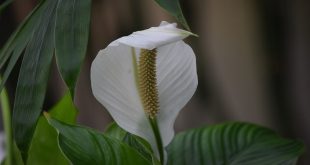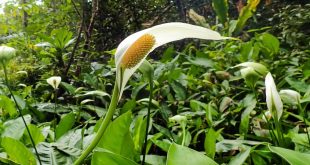The best place to plant a peace lily outside is in a shady area with indirect sunlight. It thrives in moist, well-draining soil.
Peace lilies are versatile and beautiful houseplants that can also be grown outdoors in certain regions. To ensure the best growth and health, it is crucial to choose an ideal spot for planting. A suitable location for a peace lily outside would be in a shady area where it can receive indirect sunlight, as direct sunlight can scorch its leaves.
These plants prefer moist and well-draining soil, so it is recommended to ensure the soil does not become waterlogged. With its elegant white flowers and lush green foliage, a peace lily can be a stunning addition to any outdoor space when planted correctly.
Understanding The Optimal Conditions For Peace Lily
The best place to plant a peace lily outside requires careful consideration of several factors. Understanding the natural habitat and growing conditions of peace lilies, as well as the ideal climate and temperature for their growth, will help ensure successful cultivation.
Let’s explore these aspects in detail:
Natural Habitat And Growing Conditions Of Peace Lily
- Peace lilies are native to the tropical rainforests of central and south america.
- They thrive in shaded areas with filtered light, simulating the under-canopy environment of their natural habitat.
- These plants prefer high humidity levels, necessitating positioning away from direct sunlight and drafts.
- Consistent moisture is crucial for peace lily growth, making well-draining soil and regular watering essential.
Factors To Consider When Selecting A Planting Location
- Light exposure: Choose an area with indirect sunlight or filtered light, such as a porch or under the canopy of larger trees.
- Temperature: Ensure the location remains within the temperature range of 65-85°f (18-29°c), avoiding extreme cold or heat.
- Humidity: Opt for an area with higher humidity levels, or consider regular misting to provide the necessary moisture.
- Soil type: Peace lilies thrive in well-draining, slightly acidic soil with a ph between 6.0 and 6.5.
- Space availability: Select a spot that allows the peace lily sufficient room for growth, taking into account its mature size.
Ideal Climate And Temperature For Peace Lily Growth
- Peace lilies grow best in usda hardiness zones 10-11, but they can also tolerate zones 9b-10b with proper care.
- These plants are sensitive to cold temperatures, so if you live in a region with colder winters, it’s advisable to keep them in containers for easy relocation indoors.
- Aim to maintain a temperature range of 65-85°f (18-29°c) consistently for optimal growth.
By understanding the natural habitat, growing conditions, and ideal climate for peace lilies, you can provide an environment that encourages their healthy development. With the right planting location and care, you can enjoy the beauty of peace lilies in your outdoor space.
Finding The Right Spot In Your Garden
Caring for a peace lily indoors can be a rewarding experience, but have you ever wondered if you can enjoy the beauty of this elegant plant in your outdoor garden as well? Planting a peace lily outside can add a touch of tranquility to your garden and create a welcoming atmosphere.
However, finding the perfect spot for your peace lily is crucial to ensure its optimal growth and blooming. Let’s explore some key factors to consider when choosing the right spot in your garden for your peace lily.
Assessing Available Sunlight For Outdoor Planting
- A peace lily thrives in bright indirect sunlight, making it ideal for both indoor and outdoor settings.
- Look for an area in your garden that receives partial shade, where the sunlight is filtered through some trees or a nearby building.
- Direct sunlight can scorch the leaves of the peace lily, while too little sunlight can hinder its growth and flowering.
Choosing A Non-Drafty And Protected Area
- Peace lilies prefer a sheltered spot away from strong winds and drafts.
- Avoid planting your peace lily in an area prone to gusty breezes or near open windows and doors.
- Choose a place where it can enjoy a gentle breeze while still being protected from strong winds.
Considering Soil Moisture And Drainage Requirements
- Peace lilies thrive in well-draining soil that retains a moderate level of moisture.
- Look for an area of your garden where the soil is rich, loamy, and well-drained.
- Avoid areas with compacted soil or places that tend to retain excess water, as this can lead to root rot.
Remember, finding the right spot for your peace lily in your garden is crucial for its well-being. Assess the available sunlight, choose a protected area, and ensure the soil moisture and drainage requirements are met. By providing the perfect conditions, you can enjoy the beauty and elegance of your peace lily outside for years to come.
Creating A Suitable Environment For Peace Lily
Peace lilies are known for their striking beauty and ability to thrive in indoor settings. However, if you’re looking to plant your peace lily outside, it’s important to create a suitable environment that mimics its natural habitat. Here are a few key points to consider:
Incorporating Organic Matter Into The Soil:
- Use well-draining soil that is rich in organic matter, such as compost or peat moss.
- Mix in a slow-release fertilizer to provide essential nutrients for your peace lily’s growth.
- Ensure that the soil ph is slightly acidic to neutral, ranging from 6.0 to 7.0, for optimal plant health.
Providing Adequate Water And Humidity Levels:
- Peace lilies thrive in moist environments, so it’s crucial to ensure they receive regular waterings.
- Aim to keep the soil consistently moist but not waterlogged, as excessive moisture can lead to root rot.
- Consider using a drip irrigation system or a self-watering container to maintain proper hydration levels.
- To boost humidity, mist the leaves regularly or place a tray of water near the plant.
Ensuring Proper Air Circulation Around The Plant:
- Peace lilies benefit from good air circulation, so choose a location that allows for a gentle breeze to pass through.
- Avoid planting them in areas with stagnant air, as this can promote the growth of pests and diseases.
- Prune any overcrowded foliage to promote better airflow and prevent the risk of fungal infections.
Creating an optimum environment for your peace lily outdoors will ensure its health and longevity. By incorporating organic matter into the soil, providing adequate water and humidity levels, and ensuring proper air circulation, you’ll be well on your way to enjoying the beauty of these elegant plants in an outdoor setting.
Pairing Peace Lily With Complementary Garden Plants
Peace lilies are popular indoor plants known for their elegant white flowers and dark green foliage. But have you ever considered planting peace lilies outside? They can make a stunning addition to your garden, adding a touch of grace and beauty to any landscape.
One way to truly enhance the allure of your peace lilies is by pairing them with complementary garden plants. Let’s explore some ideas on how to make the most of your outdoor peace lilies.
Companion Plants For Enhancing Peace Lily’s Beauty
- Hostas: These shade-loving plants have large, textured leaves that contrast beautifully with the peace lily’s delicate blooms. They come in a variety of colors and can create a lush backdrop for your peace lilies.
- Ferns: With their graceful fronds and feathery foliage, ferns bring a touch of elegance to any garden. Pairing them with peace lilies can create a serene and tranquil atmosphere.
- English ivy: This evergreen vine is known for its ability to cling to walls and structures, making it a great companion for peace lilies planted near fences or trellises. The ivy’s deep green leaves provide a lovely backdrop for the lily’s white flowers.
- Astilbes: These perennial flowers thrive in shade and provide a burst of color with their feathery plumes. Planting them alongside peace lilies can create a stunning visual display and add interest to your garden.
Plants That Provide Shade And Protection
- Shrubs: Consider planting shrubs like azaleas, boxwoods, or camellias around your peace lilies. These plants not only provide shade to protect the lilies from direct sunlight but also create a sense of enclosure, giving your garden a cozy and intimate feel.
- Trees: If you have space, planting a tree near your peace lilies can offer some much-needed shade. Trees like dogwoods, japanese maples, or magnolias can provide a beautiful canopy while also adding height and structure to your garden.
- Climbing plants: Vines such as clematis, jasmine, or morning glory can be trained to grow on trellises or arbors, providing shade to your peace lilies. The interplay between the climbing plants and the peace lilies can create a whimsical and enchanting garden setting.
Combining Foliage And Flowering Plants For Visual Appeal
- Heucheras: These plants are known for their colorful and eye-catching foliage, which can provide a stunning contrast to the peace lily’s flowers. Choose heucheras in shades of purple, red, or chartreuse to create a vibrant and dynamic garden display.
- Daylilies: With their vibrant and varied blooms, daylilies can add a splash of color to your garden. Combine different varieties and colors to create a stunning floral tapestry alongside the peace lilies.
- Geraniums: These versatile plants come in a wide range of colors and are known for their long blooming period. Pairing them with peace lilies can create a visually striking display that will keep your garden vibrant throughout the growing season.
By carefully selecting companion plants that enhance the beauty of peace lilies, you can create a captivating garden oasis. Whether it’s through contrasting foliage, providing shade and protection, or combining different textures and colors, these plant pairings can take your outdoor peace lilies to the next level.
So go ahead, unleash your creativity, and transform your garden into a haven of peace and tranquility with these stunning combinations.
Peace Lily In Shaded Areas: Making The Most Of A Lack Of Sunlight
Identifying areas of your garden with minimal sunlight:
- Look for areas that are predominantly shaded throughout the day, such as under trees or on the north side of buildings.
- Pay attention to the amount of indirect light these areas receive, as this is crucial for the growth of peace lilies.
- Consider using a light meter or observing the amount of shadow cast by nearby objects to determine the level of sunlight.
Strategies for maximizing growth in shaded locations:
- Opt for peace lily varieties that are known for their tolerance to low-light conditions, such as the spathiphyllum wallisii.
- Position your peace lily near windows or openings where they can receive indirect light for a few hours a day.
- Rotate the plant occasionally to ensure all sides receive adequate light and prevent the plant from leaning towards the light source.
- Consider using artificial grow lights to supplement the lack of natural sunlight, especially during the winter months.
Applying the right watering and maintenance techniques:
- Water your peace lily when the top inch of soil feels dry to the touch, as overwatering can lead to root rot.
- Use a well-draining potting mix that allows excess water to escape, preventing waterlogged soil.
- Mist the leaves regularly to increase humidity levels, as peace lilies prefer higher humidity.
- Remove yellow or dead leaves promptly to prevent any potential spread of disease or pests.
By carefully selecting shaded areas, implementing growth strategies, and providing appropriate care, you can successfully cultivate a thriving peace lily in your garden, even in areas with limited sunlight. Remember to monitor the plant’s response and adjust your care routine accordingly for optimum growth and vibrancy.
Container Gardening With Peace Lily
Benefits Of Growing Peace Lily In Containers
- Versatility: Peace lilies are well-suited for container gardening, allowing you to enjoy their beauty in various outdoor settings.
- Space-saving: Containers provide flexibility in terms of space, making it possible to cultivate peace lilies even in small gardens or balconies.
- Mobility: With potted peace lilies, you have the freedom to move them around based on sunlight and temperature requirements.
- Decorative accent: These elegant plants create a captivating visual appeal and add a touch of greenery to any outdoor living space.
Selecting The Appropriate Container Size And Material
- Size matters: Choose a container that is at least 2-4 inches larger in diameter than the current root ball of your peace lily to allow for growth.
- Material considerations: Opt for a container made of breathable materials like terracotta or plastic with drainage holes to ensure proper water drainage and prevent root rot.
- Depth requirement: Peace lilies have shallow root systems, so a container that is 6-8 inches deep should be sufficient.
- Stylish options: Consider selecting a pot that complements your outdoor aesthetic, whether it be a rustic clay pot or a modern hanging basket.
Caring For Potted Peace Lily Outside
- Sunlight requirements: Place your container in a spot that receives bright, indirect sunlight. Avoid exposing the peace lily to direct sunlight, as it can scorch the leaves.
- Watering routine: Keep the soil consistently moist, but not waterlogged. Only water when the top inch of the soil feels dry to the touch. Over-watering can lead to root rot.
- Humidity matters: Peace lilies thrive in high-humidity environments. Consider misting the leaves occasionally or placing a tray of water near the plant to increase humidity.
- Fertilizing needs: Use a balanced, water-soluble fertilizer once a month during the growing season (spring and summer) to promote healthy foliage and vibrant blooms.
- Monitoring for pests: Regularly inspect your peace lily for common pests like spider mites or mealybugs. If detected, treat them promptly with an appropriate organic or chemical solution.
Container gardening with peace lilies provides numerous benefits, including flexibility, space-saving, and aesthetic appeal. By selecting the right container size and material, as well as implementing proper care, you can create a stunning outdoor display that showcases the beauty of these elegant plants.
Remember to consider sunlight, water, humidity, and pest control to ensure your potted peace lilies thrive in their outdoor environment.
Overwintering Peace Lily In Cold Climates
Preparing peace lily for the winter season:
- As the cold weather approaches, it’s essential to take some steps to prepare your peace lily plant for the winter season.
- Trim back any dead or damaged leaves to promote healthy growth during the winter months.
- Reduce watering frequency, allowing the soil to dry out slightly between waterings.
- Consider applying a slow-release fertilizer to provide necessary nutrients for the plant during the dormant period.
Protecting the plant from frost and freezing temperatures:
- Peace lily is a tropical plant, sensitive to cold temperatures and frost. It’s crucial to safeguard it from any freezing conditions.
- Place the plant in an area that receives ample indirect sunlight. Avoid direct exposure to cold drafts or chilly windows.
- Consider bringing the plant indoors if you expect frost or temperatures below 50 degrees fahrenheit (10 degrees celsius).
- If you prefer to keep the plant outside, cover it with a frost cloth or lightweight fabric to provide some insulation.
Strategies for ensuring the survival of peace lily during winter:
- Insulate the pot by placing it on a layer of mulch or even wrapping it in bubble wrap for added protection against freezing temperatures.
- Create a mini greenhouse effect by placing the plant in a larger plastic plant container with air spaces to trap warm air.
- If possible, move the plant to a more sheltered location, such as a covered porch or under a tree canopy, to shield it from harsh winds.
- Monitor the soil moisture level carefully, ensuring it doesn’t become too dry or overly saturated during the winter months.
Remember, to successfully overwinter your peace lily in cold climates, a combination of proper preparation, protection, and strategic care is vital. By following these guidelines, you can help your peace lily thrive and survive through the winter season.
Troubleshooting Common Issues With Outdoor Peace Lily
Recognizing Signs Of Stress Or Nutrient Deficiency:
- Yellowing leaves: This is a common sign of stress in outdoor peace lilies. It may indicate either overwatering or underwatering.
- Brown spots on leaves: Brown spots can be caused by too much direct sunlight. Peace lilies prefer bright, indirect light, so it’s essential to provide them with some shade.
- Wilting leaves: If your outdoor peace lily is wilting, it could be a sign of both underwatering and overwatering. Ensure that you’re watering the plant appropriately and allowing the soil to dry out slightly between waterings.
- Stunted growth: Nutrient deficiencies, such as insufficient nitrogen or potassium, can lead to stunted growth in peace lilies. Consider using a balanced fertilizer to provide the necessary nutrients.
Dealing With Pests And Diseases Affecting Outdoor Plants:
- Aphids: These tiny, sap-sucking insects can infest outdoor peace lilies. Use an insecticidal soap or neem oil to control aphids and prevent them from damaging your plants.
- Scale insects: Scale insects are often found on the stems and leaves of outdoor plants. Use a cotton swab soaked in rubbing alcohol to remove them, or consider using insecticidal soap.
- Mealybugs: Mealybugs are common pests that can affect peace lilies. Wipe them off with a cotton swab dipped in alcohol or apply insecticidal soap to control their population.
- Root rot: Root rot is a fungal disease that occurs due to overwatering. Ensure that the soil drains well and avoid overwatering to prevent this disease.
Tips For Maintaining Healthy And Vibrant Peace Lily Foliage:
- Light requirements: Outdoor peace lilies thrive in bright, indirect light. Place them in an area with filtered sunlight or provide some shade to avoid direct exposure to harsh sunlight.
- Watering: Water the plant when the top inch of soil feels dry. Do not overwater, as peace lilies are susceptible to root rot. Ensure proper drainage to prevent water from accumulating around the roots.
- Humidity: Peace lilies prefer high humidity levels. You can increase humidity by misting the leaves with water or placing a tray filled with water near the plant.
- Fertilizing: Use a balanced, water-soluble fertilizer for outdoor peace lilies. Follow the instructions on the fertilizer package for the correct dosage and frequency.
- Pruning: Remove any yellow or brown leaves to maintain the plant’s appearance and overall health. Trim crowded or damaged stems to allow better air circulation.
By following these troubleshooting tips and maintaining the appropriate growing conditions, you can ensure that your outdoor peace lily stays healthy and vibrant, adding beauty to your garden or outdoor space. Remember to observe the plant regularly for any signs of stress or pest infestations, and take prompt action to address these issues.
Frequently Asked Questions For Where Is The Best Place To Plant Peace Lily Outside?
Can I Plant A Peace Lily Outside In Direct Sunlight?
Yes, peace lilies prefer bright but indirect sunlight. Direct sunlight can scorch the leaves, so it’s best to place them in a well-lit spot with some shade.
How Often Should I Water A Peace Lily Planted Outside?
Water your peace lily planted outside when the top inch of soil feels dry. Avoid overwatering as it can lead to root rot. It’s better to underwater slightly than to keep the soil too wet.
What Type Of Soil Is Best For Planting A Peace Lily Outside?
A well-draining potting soil with a mix of peat moss, perlite, and compost is ideal for planting peace lilies outside. This type of soil helps retain enough moisture while preventing waterlogged conditions.
Can I Plant A Peace Lily Outside In A Cold Climate?
Peace lilies are tropical plants and cannot tolerate frost or temperatures below 45°f (7°c). If you live in a cold climate, it’s best to keep your peace lily indoors or consider it as an annual outdoor plant during the warmer months.
How Often Should I Fertilize A Peace Lily Outside?
Fertilize your peace lily with a balanced houseplant fertilizer every two to three months during the growing season. Dilute the fertilizer to half strength and apply it to damp soil, avoiding direct contact with the leaves.
How Can I Protect My Outdoor Peace Lily From Pests?
Monitor your outdoor peace lily regularly for pests like aphids, mealybugs, or spider mites. Use insecticidal soap or neem oil spray to treat any infestations, ensuring to thoroughly cover both the top and bottom of the leaves.
Conclusion
Finding the best place to plant your peace lily outside is crucial for its growth and well-being. Remember to choose a location with bright, indirect sunlight that mimics its natural habitat. Ensure that the soil is well-drained and rich in organic matter, as this will provide the necessary nutrients for the plant to thrive.
Consider planting the peace lily in a shady spot, such as under a tree or on a covered patio, to protect it from harsh sunlight and excessive heat. Monitor the moisture levels regularly, as over-watering or drought can be detrimental to the plant’s health.
By following these guidelines, you can create an ideal environment for your peace lily to flourish and enjoy its beautiful green leaves and stunning white flowers.
 GardenXpert Garden Advice Blog
GardenXpert Garden Advice Blog





